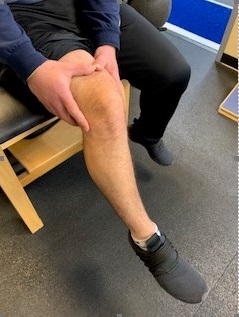12/14/2021
The Benefits of Using Ultrasound: Improving Accuracy and Relief
By Jennifer Hopp, MD, CAQSM, Wentworth Health Partners Seacoast Orthopedics & Sports Medicine
Ultrasound is a form of imaging in real time that is being used more frequently to image and inject various injuries related to the shoulder, hip, knee and tendons. You may think ultrasound is only used for monitoring a pregnancy, but with advances in technology, ultrasound machines are smaller and have become more readily available to be used in a doctors’ offices. Ultrasound works by using high frequency sound waves to produce real-time, dynamic images of the body right in the clinic. Gel is applied to the skin and a hand-held ultrasound probe is scanned along a body part, producing images of bone, blood vessels, nerves and soft tissue structures such as muscles and tendons. It can be used as part of an exam to better identify injuries and sources of pain. As opposed to an X-ray which only shows bones, ultrasound has no radiation, so risk to the patient is virtually non-existent.
injuries related to the shoulder, hip, knee and tendons. You may think ultrasound is only used for monitoring a pregnancy, but with advances in technology, ultrasound machines are smaller and have become more readily available to be used in a doctors’ offices. Ultrasound works by using high frequency sound waves to produce real-time, dynamic images of the body right in the clinic. Gel is applied to the skin and a hand-held ultrasound probe is scanned along a body part, producing images of bone, blood vessels, nerves and soft tissue structures such as muscles and tendons. It can be used as part of an exam to better identify injuries and sources of pain. As opposed to an X-ray which only shows bones, ultrasound has no radiation, so risk to the patient is virtually non-existent.
 Your physician may have recommended a steroid injection to treat pain associated with arthritis, tendonitis or bursitis in knees, hips and shoulders. Steroid injections can help reduce inflammation and improve pain. Another useful injection is Platelet Rich Plasma, or PRP for short. PRP is a concentration of platelets from a patient’s own blood and is often used to accelerate healing of tendonitis and improve pain associated with arthritis. Ultrasound is often utilized to improve accuracy of injections to joints, muscles and tendons. Injections can be both diagnostic and therapeutic. “Blind” injections, even in expert hands, are not 100% accurate. Depending on the location, some “blind” injections can be as low as 30-40% accurate. By using ultrasound, a physician can visualize the needle as it enters the skin and traverses to the desired location. Ultrasound guided injections have 90-100% accuracy. They are often less painful to receive as well, due to the ease and speed of locating the correct location compared to “blind” injections.
Your physician may have recommended a steroid injection to treat pain associated with arthritis, tendonitis or bursitis in knees, hips and shoulders. Steroid injections can help reduce inflammation and improve pain. Another useful injection is Platelet Rich Plasma, or PRP for short. PRP is a concentration of platelets from a patient’s own blood and is often used to accelerate healing of tendonitis and improve pain associated with arthritis. Ultrasound is often utilized to improve accuracy of injections to joints, muscles and tendons. Injections can be both diagnostic and therapeutic. “Blind” injections, even in expert hands, are not 100% accurate. Depending on the location, some “blind” injections can be as low as 30-40% accurate. By using ultrasound, a physician can visualize the needle as it enters the skin and traverses to the desired location. Ultrasound guided injections have 90-100% accuracy. They are often less painful to receive as well, due to the ease and speed of locating the correct location compared to “blind” injections.
Another benefit of using ultrasound, is the dynamic, real-time feedback while scanning or injecting the body. With MRI and CT scans, a patient must remain immobile for 5-45 minutes, depending on which body part is being imaged. However, with ultrasound, the joint or muscle can be moved and touched during the imaging process, helping to better pinpoint the diagnosis in real time. At Seacoast Orthopedics and Sports Medicine, our sports medicine physicians are adept at the use of musculoskeletal ultrasound, which is available at all three of our locations (Somersworth, Lee and Pease).
Jennifer Hopp, MD, is a board-certified Primary Care Sports Medicine Physician. She is the Program Director for the Women’s Sports Medicine Program, specializing in multi-disciplinary care for active and athletic female patients. She cares for athletes of all ages and abilities, from the weekend warrior to the professional athlete. Prior to moving to New Hampshire in 2020, she was the team physician at several high schools and the University of Richmond. She is a team physician at the University of New Hampshire and enjoys providing medical coverage for games and races. An avid runner and cyclist herself, she has experienced many injuries first hand and understands that recovering from an injury is just as important as being an athlete.
